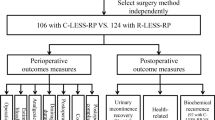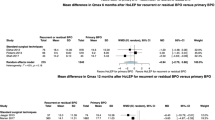Abstract
Background
Transurethral resection of the prostate is the most commonly performed procedure for the management of benign prostatic obstruction. However, little is known about the effect surgical duration has on complications. We assess the relationship between operative time and TURP complications using a modern national surgical registry.
Methods
We queried the American College of Surgeons National Surgical Quality Improvement Program (ACS NSQIP) from 2006 to 2016 for patients undergoing TURP. Patients were separated into five groups based on operative time: 0–30 min, 30.1–60 min, 60.1–90 min, 90.1–120 min, and greater than 120 min. Standard statistical analysis, including multivariate regression, was performed to determine factors associated with complications.
Results
31,813 patients who underwent TURP were included. The overall complication rate was 9.0% and increased significantly with longer surgical duration (p < 0.001). Longer operative time was associated with a greater risk of postoperative sepsis or shock, transfusion, reoperation, and deep vein thrombus or pulmonary embolism. Longer surgical duration was associated with increased odds of any complication and, specifically, blood transfusion after controlling for age, race, comorbidities, American Society of Anesthesia (ASA) class, type of anesthesia administered, and trainee involvement. The adjusted risk of each of the above complications remained significantly increased for surgeries lasting longer than 120 min.
Conclusions
As surgical duration increases, there is a significant increase in the rate of complications after TURP. These data demonstrate that this procedure is safest when performed in under 90 min.
This is a preview of subscription content, access via your institution
Access options
Subscribe to this journal
Receive 4 print issues and online access
$259.00 per year
only $64.75 per issue
Buy this article
- Purchase on Springer Link
- Instant access to full article PDF
Prices may be subject to local taxes which are calculated during checkout
Similar content being viewed by others
References
Oelke M, Bachmann A, Descazeaud A, et al. EAU guidelines on the treatment and follow-up of non-neurogenic male lower urinary tract symptoms including benign prostatic obstruction. Eur Urol. 2013;64:118–40. https://doi.org/10.1016/j.eururo.2013.03.004.
Malaeb BS, Yu X, McBean AM, Elliott SP. National trends in surgical therapy for benign prostatic hyperplasia in the United States (2000-2008). Urology. 2012;79:1111–6. https://doi.org/10.1016/j.urology.2011.11.084.
Chughtai BI, Simma-Chiang V, Lee R, et al. Trends and utilization of laser prostatectomy in ambulatory surgical procedures for the treatment of benign prostatic hyperplasia in New York state (2000-2011). J Endourol. 2015;29:700–6. https://doi.org/10.1089/end.2014.0692.
Bhojani N, Gandaglia G, Sood A, et al. Morbidity and mortality after benign prostatic hyperplasia surgery: data from the American College of Surgeons national surgical quality improvement program. J Endourol. 2014;28:831–40. https://doi.org/10.1089/end.2013.0805.
Mebust WK, Holtgrewe HL, Cockett AT, Peters PC. Transurethral prostatectomy: immediate and postoperative complications. A cooperative study of 13 participating institutions evaluating 3,885 patients. J Urol. 1989;141:243–7.
Doll HA, Black NA, McPherson K, Flood AB, Williams GB, Smith JC. Mortality, morbidity and complications following transurethral resection of the prostate for benign prostatic hypertrophy. J Urol. 1992;147:1566–73.
Rassweiler J, Teber D, Kuntz R, Hofmann R. Complications of transurethral resection of the prostate (TURP)--incidence, management, and prevention. Eur Urol. 2006;50:969–79. https://doi.org/10.1016/j.eururo.2005.12.042. discussion980.
Reich O, Gratzke C, Bachmann A, et al. Morbidity, mortality and early outcome of transurethral resection of the prostate: a prospective multicenter evaluation of 10,654 patients. J Urol. 2008;180:246–9. https://doi.org/10.1016/j.juro.2008.03.058.
Stucki P, Marini L, Mattei A, Xafis K, Boldini M, Danuser H. Bipolar versus monopolar transurethral resection of the prostate: a prospective randomized trial focusing on bleeding complications. J Urol. 2015;193:1371–5. https://doi.org/10.1016/j.juro.2014.08.137.
Mayer EK, Kroeze SGC, Chopra S, Bottle A, Patel A. Examining the “gold standard”: a comparative critical analysis of three consecutive decades of monopolar transurethral resection of the prostate (TURP) outcomes. BJU Int. 2012;110:1595–601. https://doi.org/10.1111/j.1464-410X.2012.11119.x.
Skolarikos A, Rassweiler J, de la Rosette JJ, et al. Safety and efficacy of bipolar versus monopolar transurethral resection of the prostate in patients with large prostates or severe lower urinary tract symptoms: post hoc analysis of a european multicenter randomized controlled trial. J Urol. 2016;195:677–84. https://doi.org/10.1016/j.juro.2015.08.083.
Bach T, Wölbling F, Gross AJ, et al. Prospective assessment of perioperative course in 2648 patients after surgical treatment of benign prostatic obstruction. World J Urol. 2017;35:285–92. https://doi.org/10.1007/s00345-016-1866-7.
Mamoulakis C, Ubbink DT, de la Rosette JJMCH. Bipolar versus monopolar transurethral resection of the prostate: a systematic review and meta-analysis of randomized controlled trials. Eur Urol. 2009;56:798–809. https://doi.org/10.1016/j.eururo.2009.06.037.
Tang Y, Li J, Pu C, et al. Bipolar transurethral resection versus monopolar transurethral resection for benign prostatic hypertrophy: a systematic review and meta-analysis. J Endourol. 2014;28:1107–14. https://doi.org/10.1089/end.2014.0188.
Cornu J-N, Ahyai S, Bachmann A, et al. A systematic review and meta-analysis of functional outcomes and complications following transurethral procedures for lower urinary tract symptoms resulting from benign prostatic obstruction: an update. Eur Urol. 2015;67:1066–96. https://doi.org/10.1016/j.eururo.2014.06.017.
Shiloach M, Frencher SK, Steeger JE, et al. Toward robust information: data quality and inter-rater reliability in the American College of Surgeons National Surgical Quality Improvement Program. J Am Coll Surg. 2010;210:6–16. https://doi.org/10.1016/j.jamcollsurg.2009.09.031.
Haridas M, Malangoni MA. Predictive factors for surgical site infection in general surgery. Surgery. 2008;144:496–501. https://doi.org/10.1016/j.surg.2008.06.001. discussion501-503.
Hollenbeck BK, Miller DC, Taub D, et al. Risk factors for adverse outcomes after transurethral resection of bladder tumors. Cancer . 2006;106:1527–35. https://doi.org/10.1002/cncr.21765.
Matulewicz RS, Sharma V, McGuire BB, Oberlin DT, Perry KT, Nadler RB. The effect of surgical duration of transurethral resection of bladder tumors on postoperative complications: an analysis of ACS NSQIP data. Urol Oncol. 2015;33:338.e19–24. https://doi.org/10.1016/j.urolonc.2015.05.011.
Procter LD, Davenport DL, Bernard AC, Zwischenberger JB. General surgical operative duration is associated with increased risk-adjusted infectious complication rates and length of hospital stay. J Am Coll Surg. 2010;210:60–65.e1-2. https://doi.org/10.1016/j.jamcollsurg.2009.09.034.
Uchida T, Ohori M, Soh S, et al. Factors influencing morbidity in patients undergoing transurethral resection of the prostate. Urology. 1999;53:98–105.
Gilling PJ, Mackey M, Cresswell M, Kennett K, Kabalin JN, Fraundorfer MR. Holmium laser versus transurethral resection of the prostate: a randomized prospective trial with 1-year followup. J Urol. 1999;162:1640–4.
Kuntz RM, Ahyai S, Lehrich K, Fayad A. Transurethral holmium laser enucleation of the prostate versus transurethral electrocautery resection of the prostate: a randomized prospective trial in 200 patients. J Urol. 2004;172:1012–6. https://doi.org/10.1097/01.ju.0000136218.11998.9e.
Vivien A, Lazard T, Rauss A, Laisné MJ, Bonnet F. Infection after transurethral resection of the prostate: variation among centers and correlation with a long-lasting surgical procedure. Association pour la Recherche en Anesthésie-Réanimation. Eur Urol. 1998;33:365–9.
Fan S, Gong B, Hao Z, et al. Risk factors of infectious complications following flexible ureteroscope with a holmium laser: a retrospective study. Int J Clin Exp Med. 2015;8:11252–9.
Lojanapiwat B, Kitirattrakarn P. Role of preoperative and intraoperative factors in mediating infection complication following percutaneous nephrolithotomy. Urol Int. 2011;86:448–52. https://doi.org/10.1159/000324106.
Colau A, Lucet JC, Rufat P, Botto H, Benoit G, Jardin A. Incidence and risk factors of bacteriuria after transurethral resection of the prostate. Eur Urol. 2001;39:272–6. 52452.
Wagenlehner FME, Wagenlehner C, Schinzel S, Naber KG, Working Group. “Urological Infections” of German Society of Urology. Prospective, randomized, multicentric, open, comparative study on the efficacy of a prophylactic single dose of 500 mg levofloxacin versus 1920 mg trimethoprim/sulfamethoxazole versus a control group in patients undergoing TUR of the prostate. Eur Urol. 2005;47:549–56. https://doi.org/10.1016/j.eururo.2005.01.004.
JTH SchaepkensVanRiempst, RHGG VanHee, JJJ Weyler. Deep venous thrombosis after laparoscopic cholecystectomy and prevention with nadroparin. Surg Endosc. 2002;16:184–7. https://doi.org/10.1007/s004640090048.
Clarke-Pearson DL, Dodge RK, Synan I, McClelland RC, Maxwell GL. Venous thromboembolism prophylaxis: patients at high risk to fail intermittent pneumatic compression. Obstet Gynecol. 2003;101:157–63.
Olcese SP, Derosa R, Kern SQ, Lustik MB, Sterbis JR, McMann LP. Comparison of outcomes after TURP versus photoselective vaporization of the prostate with respect to trainee involvement utilizing ACS NSQIP. Prostate Cancer Prostatic Dis. 2014;17:227–32. https://doi.org/10.1038/pcan.2014.13.
Author information
Authors and Affiliations
Corresponding author
Ethics declarations
Conflict of interest
The authors declare that they have no conflict of interest.
Rights and permissions
About this article
Cite this article
Riedinger, C.B., Fantus, R.J., Matulewicz, R.S. et al. The impact of surgical duration on complications after transurethral resection of the prostate: an analysis of NSQIP data. Prostate Cancer Prostatic Dis 22, 303–308 (2019). https://doi.org/10.1038/s41391-018-0104-3
Received:
Revised:
Accepted:
Published:
Issue Date:
DOI: https://doi.org/10.1038/s41391-018-0104-3
This article is cited by
-
Rezŭm water vaporization therapy versus transurethral resection of the prostate in the management of refractory urine retention: matched pair comparative multicenter experience
World Journal of Urology (2024)
-
Pathogen species are the risk factors for postoperative infection of patients with transurethral resection of the prostate: a retrospective study
Scientific Reports (2023)



